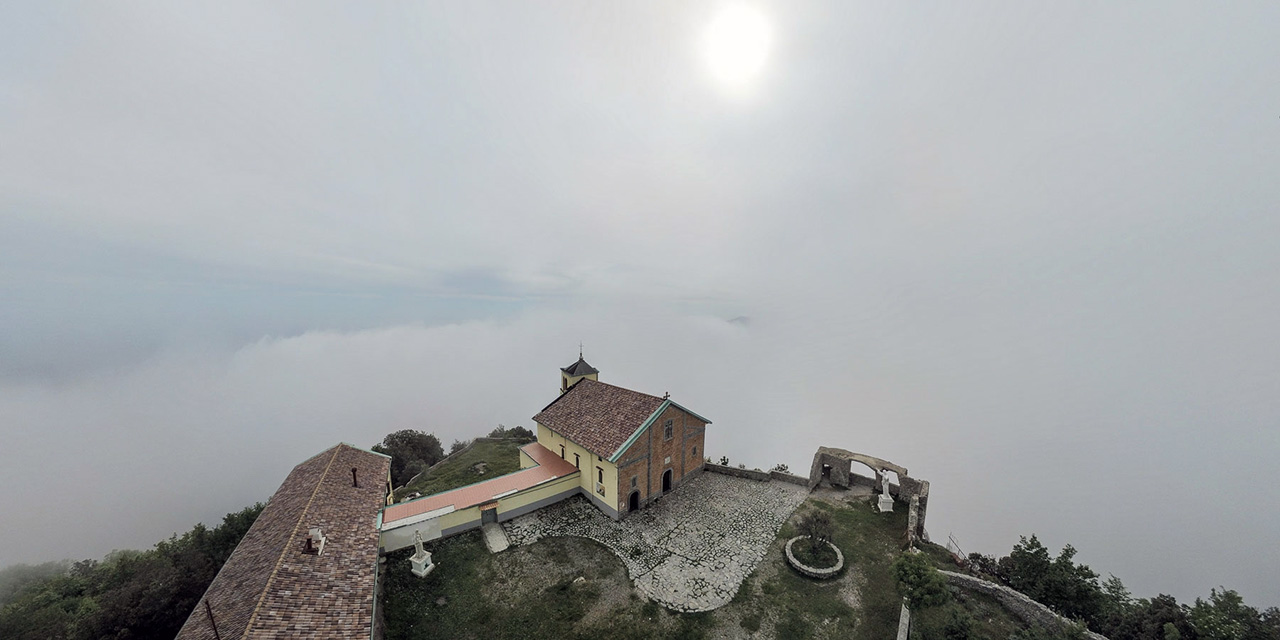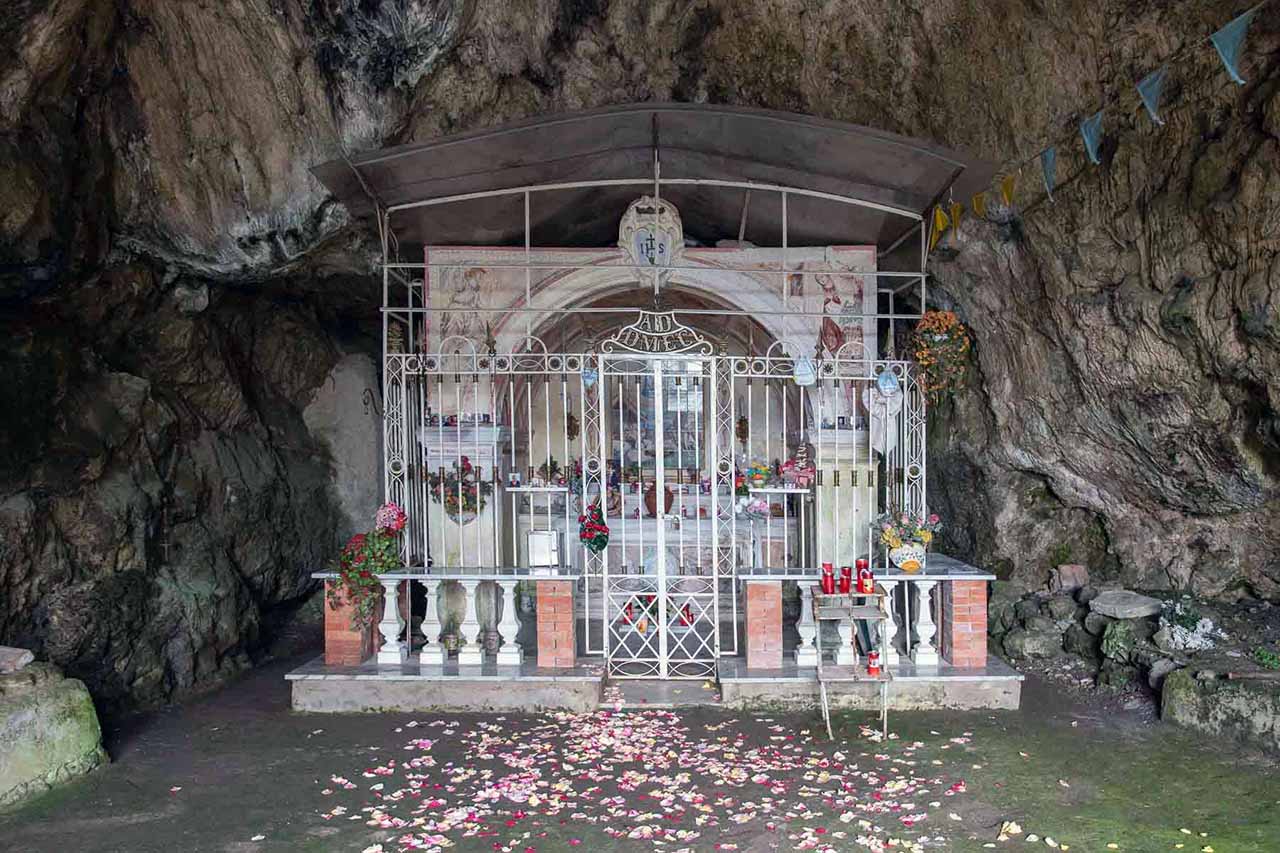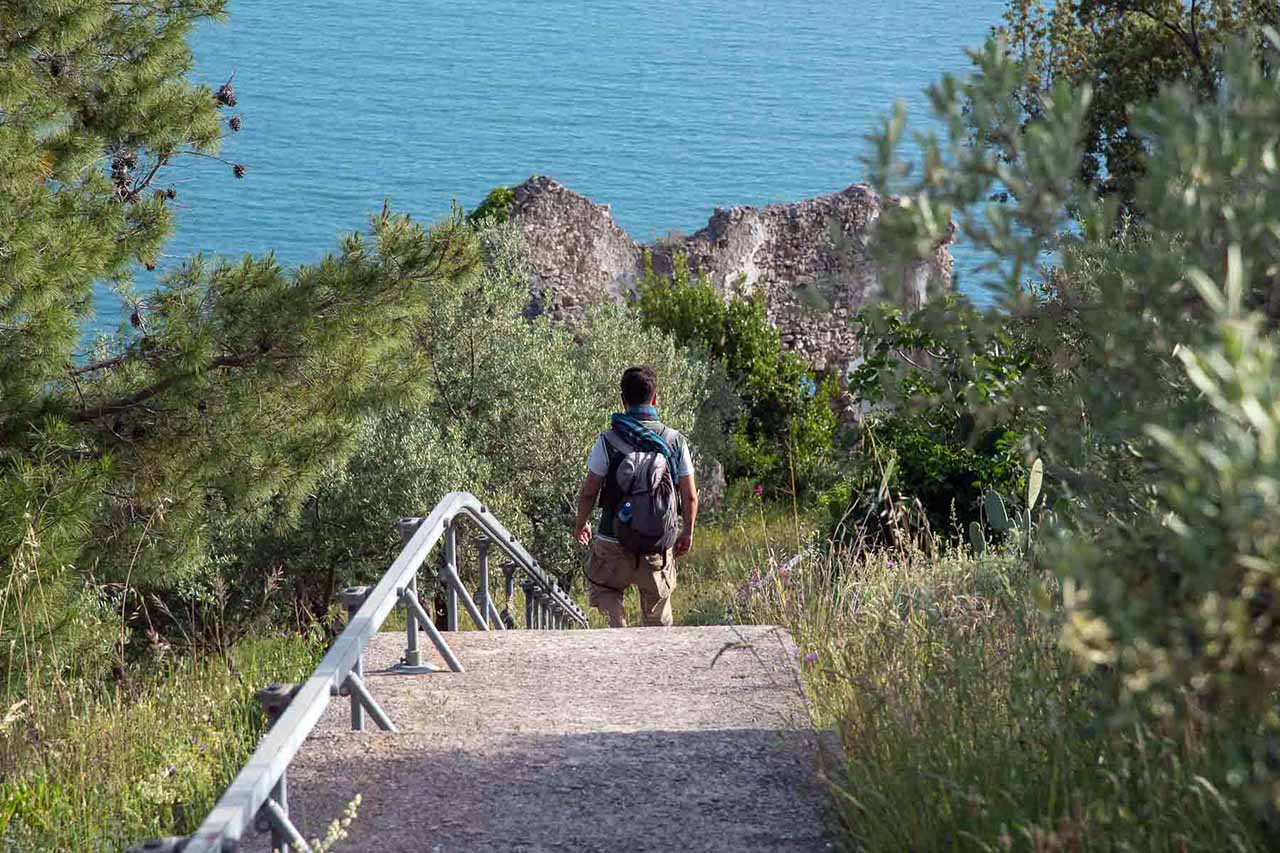Holy Masses are celebrated on the third Sunday of the month from May to October, and solemn celebrations occur on the Monday after Pentecost.
May 5th, 2021. By Annamaria Parlato, photo by Salvatore Guadagno
Those who choose to reach the Sanctuary of the Avvocata of Maiori will discover an itinerary incorporating the breathtaking views of the Gulf of Salerno and the Amalfi Coast. The search for the divine came from the purifying and cathartic asceticism on Mount Falesio, also underlined by anthropologists. The wide-open spaces overlooking the sea will push the visitor without any forcing towards the contemplation of infinity.
It all happened way back in November 1485
Over the centuries, the Madonna dell’Avvocata Sanctuary has awakened a profound sense of devotion in the inhabitants of the Coast and beyond. It can be reached from Maiori through a steep path, which has never discouraged pilgrims and hikers from going to the place, as so strong is the “sensus fidei” towards it. You can get there, making some stops along the way, using either a mule track that starts from the Badia di Cava or a long staircase that departs from Maiori.
The most used path is the one that begins from the Abbey of the Benedictines of the SS. Trinità of Cava Dei Tirreni, but there are also other steeper routes taken from Maiori, Erchie, and Cetara. Currently, the Sanctuary is managed by the Benedictine monks of the Avvocatella di Cava. Father Gennaro Lo Schiavo was a rector and exorcist until March 2021, mentor and spiritual guide with a significant impact on many pilgrims from every corner of Campania.
They followed him assiduously until the day of his death due to Covid-19 infection and worsening health conditions. The origins of the Sanctuary date back to the 15th century. A Maiorese shepherd, Gabriello Cinnamo, led by a dove, discovered a cave with his boy of Salerno, Dattilo Parìto. Later the Virgin appeared to Gabriello in a dream and asked him to build an altar in the cave in her honor. In return, she would be his “Advocate.”

The Sanctuary in the local literature
In the book “Historical, archaeological, topographical scrutiny of Maiori” by Filippo Cerasuoli from 1865, the Sanctuary is mentioned as the Hermitage of the Camaldolesi. In 1686 the management of the plexus passed into the hands of the previous order, which held control until 1807, when, following the Napoleonic laws of monastic suppression, the building with an adjoining church and hermitage suffered devastation and fires, gradually taking on the features of ruin. Instead, the tiny book published in 1893 by Alfonso Scannapieco, secretary of the Municipality of Maiori, tells about what happened after 1807, precisely in 1866, with the decree of Vittorio Emanuele II of Savoy, the religious corporations were suppressed.
The State Property confiscated the hermitage with all the surrounding woods belonging to the Chapter of Amalfi, which Giuseppe Civale then purchased in 1872. When he died in 1879, various heirs succeeded in his possessions, which were assigned to Matteo Primicerio, the forest part with the cave and the Sanctuary, and Giuseppe Tajani, the other wood, the ruins of the hermitage.
In 1888 the bricklayer Antonio Manzi, having ascertained the highly critical state of the place, redeemed it. He cleaned up the walls with great determination, restored the altar in the cave, and printed the following inscription in Roman characters: “Restored in MDCCCLXXXX.” Manzi also built a small factory fence, making the place much more dignified. Gradually the devotion of the Maiorese people to the Advocate, who became dear to them, was reactivated.
In 1892 the mayor asked for and obtained the owners’ sale of the cave and the upper area for public worship. Finally, Giuseppe Primicerio, in the literary text “The City of Maiori from its origins to our times” of 1983, described in great detail the history of the Sanctuary, focusing on the anthropological and cultural importance of the site for the entire community both from a social point of view how religious.

Tammurriate and a shower of rose petals
The pilgrimage to the Madonna dell’Avvocata occurs every year on Whit Monday. On this occasion, people from all over Campania climb to the top of the Sanctuary, following the tammorre (an old musical instrument) rhythm. Generally, the climb takes place on Sunday with a break during the night or at the first light of dawn on Monday. At noon the songs and dances stop, and the Madonna is carried in procession. A dense rain of rose petals is scattered everywhere, and everyone screams Hurray, Maria, Hurray! The party then continues until late at night, and the gesture of faith is repeated in the octave.
In a niche above the main altar is the statue of the Madonna made in the 1940s by some craftsmen from Ortisei; it was blessed and crowned by Pope John Paul II in Rome on April 3, 2002. The tammurriata has ancient origins that date back to the Greek world and the dances of the Campania peoples, such as the Samnites. At the time of the Greeks, dance was considered a gift from the gods through which men could approach divinity and have the illusion of immortality.
For the Samnites, the dance was a propitiatory rite linked to the reproductive cycle of the earth. That of the Avvocata differs from the other tammurriate for some characteristics. The players are numerous and play their instruments for many hours. In pairs, the dancers perform the ritual dance, trying to conquer the space of the other dancers with different movements, who can, aided by the sound of castanets or castanets, support the aggressor, or face him.
The clash climaxes in the so-called intertwining: a vault with legs that cross between one duelist and another. The ancestral meaning is exact: in nature, opposites come together in a harmonious whole that allows man to live. This dance is a gratitude gesture to the Virgin, who acts as a guarantor, that is, as the “Advocate” of this harmony of opposites, making life easier for the inhabitants of the impassable Coast.

A breathtaking path for trekking lovers
If you leave the town of Maiori via Lama in Casale dei Cicerali, take a mountain path, which becomes more and more sloping as you proceed towards the top of Monte Falesio at 1024 meters above sea level. After a first stop in the locality of Santa Maria, walking for about fifteen minutes, you will come across a spring called by the locals “Water or chestnuts,” which takes its name from the vegetation present.
After a short stretch, two branches lead to the Sanctuary: one shorter and more inaccessible, the other longer and more comfortable. Along the way, we reach the Soppressate Grotto, which owes its name to the shape of the stalactites that hang inside it, similar to the typical local salami. Then you arrive at the actual Sanctuary at 866 meters above sea level, consisting of three distinct bodies: the Grotto of the Apparition, the Church, and the Monastery.

The celebrations in September and a particular helicopter made available by the Municipality of Maiori
In September, the Marian celebrations are renewed, and Mayor Antonio Capone lives this anniversary firsthand, organizing a particular helicopter with the municipal administration to facilitate older people’s movement. “As for many Maiorese, the Avvocata Sanctuary represents a place of the soul, where spirituality blends with the divine landscape beauty.” Mayor Capone continues with deep admiration: “I am linked to this special place by numerous memories, all closely connected to some of our most heartfelt traditions, such as that of the pilgrimage on the Monday following Pentecost: a centuries-long devotion, in which paganism and Christianity intertwine. Or, again, the Feast held during September, a recurrence deeply felt by the elders of Maiori. They keep their faith and sense of belonging alive by participating in the solemn mass and preparing lunch, which my administration has always supported. Which contributes to facilitating helicopter transport for the elderly faithful”.
Giuseppe Primicerio, mentioned above, recalled in his texts the priority to favor the expansion to the cult of a site so renowned in the vast territory, including the Amalfi Coast. Such places are Agro Nocerino Sarnese, Valle Metelliana, and the Salerno, addressing radically and definitively the problem of making access to the hermitage easier and more comfortable. After several years of waiting, some essential pieces have finally been added.
Mayor Capone declared: “I believe it is necessary to implement the use of this site of enormous religious, cultural, and naturalistic value. This is why I worked hard to support the Campania Region project for the redevelopment of the Sanctuary square, as well as in planning concerted interventions with the Monti Lattari Mountain Community for the cleaning and safety of the path. I hope that more and more pilgrims, visitors, and tourists will be able to experience the unique emotions that the journey to the Sanctuary of the Avvocata offers and appreciate the divine beauty of a place without equal”.
The Avvocata and the Maiori Festival
The beauty and charm surrounding the demanding ascent towards the dreamlike sacred place overlooking Maiori and the Amalfi Coast are admired by many visitors who want to experience the territory in the most authentic way possible to merge, mix and tell the peculiarities and the authenticity of the place.
The Maiori Festival (from May to October) effectively enhances all the territorial resources by creating opportunities and offers that combine culture, art, traditions, food, and wine, nature, and well-being. “The sea and the mountains combined with the history of the place, – says Salvatore Dell’Isola, President of the cultural association Il Tempio di Apollo and Artistic Director of the Festival -, provide a wonderful backdrop to the initiative “On the pilgrims’ steps: towards the Sanctuary dell’Avvocata, scheduled for September 19, which includes at the end of the route, the concert and tasting at high altitude, all enriched by a traditional experience such as the ascent on the saddle of the typical mules of the Lattari Mountains. A place that has all the credentials to identify itself as a paradise and put its heritage at the center of its narrative”.
